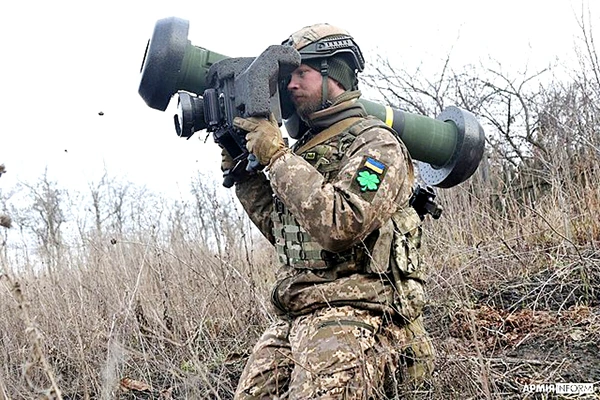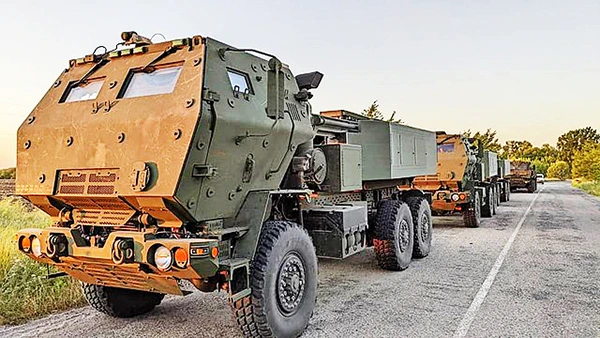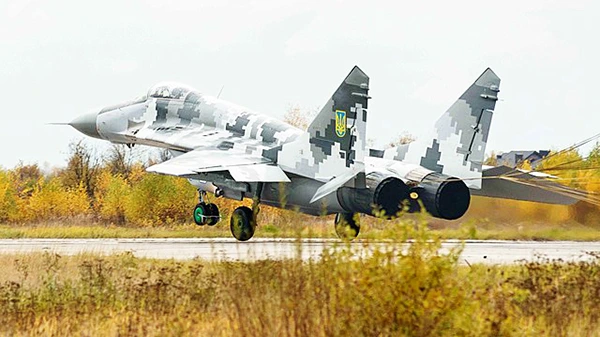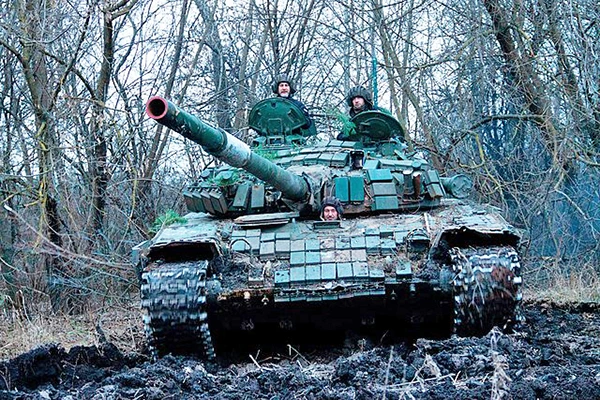Some Ukrainian land weapon systems and platforms have been quite effective and have had a profound effect in the war against Russia.
The High Mobility Artillery Rocket System (HIMARS) has been the most effective against Russian targets. HIMARS is a mobile, self-propelled artillery system that can fire a salvo of six rockets up to 80 kilometers away. The rockets are guided, meaning they can hit their targets with a high degree of accuracy. This makes HIMARS ideal for targeting Russian command centers, supply depots, and other critical infrastructure behind the front lines.
Since the arrival of HIMARS in Ukraine, the Ukrainian military has been able to inflict significant damage on the Russian military. In June 2023, for example, Ukrainian forces used HIMARS to destroy a Russian ammunition depot in the Donbas region.
HIMARS has also been credited with helping to turn the tide of the war in Ukraine. In the early stages of the war, the Russian military was able to make significant gains. However, the arrival of HIMARS has given the Ukrainian military the ability to strike back at the Russians from a distance forcing them to focus on defending their own positions.
Characteristics of HIMARS System
The HIMARS is a light multiple rocket launcher developed in the late 1990s for the United States Army. It is mounted on a standard United States Army Family of Medium Tactical Vehicles (FMTV) truck frame. The HIMARS carries one pod with either six Guided Multiple Launch Rocket System (GMLRS) rockets or one Army Tactical Missile System (ATACMS) missile. It is capable of launching all rockets specified in the Multiple Launch Rocket System Family of Munitions (MFOM).
Mobility: The HIMARS is mounted on a wheeled vehicle, which gives it a high degree of mobility. It can be transported by C-130 aircraft, which allows it to be rapidly deployed to any theater of operations.
Accuracy: The HIMARS can fire guided rockets with a high degree of accuracy against command centers, supply depots, and other critical infrastructure.
Range: The HIMARS can fire its rockets up to 80 kilometers away. This gives it the ability to strike enemy targets from a distance, which reduces the risk of its own forces being exposed to enemy fire.
Survivability: The HIMARS is a relatively small and lightly armored vehicle. However, it is equipped with a fire suppression system and other features that help to protect its crew from enemy fire.
The HIMARS system has been used in combat by the United States Army and Marine Corps in Iraq and Afghanistan.




Ukrainian Tanks
The most effective tank used by the Ukrainians against the Russians has been the T-72. The T-72 is a Soviet-era main battle tank that has been in service with the Ukrainian military since the 1970s. It is a relatively simple and reliable tank, and it is well-suited for the conditions in Ukraine.
The T-72 has been upgraded by the Ukrainians with a number of features, including improved armor, a new fire control system, and a more powerful gun. These upgrades have made the T-72 a more effective tank against the Russian T-72s and T-80s.
In addition to the T-72, the Ukrainians have also used other tanks, such as the T-64 and the T-80, against the Russians. However, the T-72 has been the most effective tank used by the Ukrainians.
Here are some of the reasons why the T-72 has been so effective against the Russians:
Numbers: The Ukrainians have a large number of T-72s in their inventory. This means that they have a lot of tanks to throw at the Russians.
Reliance on old technology: The Russians have relied on older technology in their tanks, such as the T-72. This has made them vulnerable to the newer Ukrainian tanks, such as the T-72M1R.
Tactics: The Ukrainians have been using the T-72s effectively in combined arms operations. This means that they have been using the tanks in conjunction with other weapons systems, such as artillery and infantry, to achieve success.
Characteristics of T-72 Tank
The T-72 has been upgraded by the Ukrainians with a number of features, including improved armor, a new fire control system, and a more powerful gun. These upgrades have made the T-72 a more effective tank against the Russian T-72s and T-80s.
Armor: The T-72 has a well-sloped armor that provides good protection against enemy fire. The armor is made up of steel and composite materials, and it is designed to defeat HEAT, APFSDS, and HE rounds.
Armament: The T-72 is armed with a 125mm smoothbore gun that can fire a variety of ammunition, including HEAT, APFSDS, and HE rounds. The gun is mounted in a turret that can rotate 360 degrees.
Fire control system: The T-72 is equipped with a fire control system that includes a laser range finder, a thermal sight, and a ballistic computer. This system allows the tank to engage targets accurately at long range.
Engine: The T-72 is powered by a V-12 diesel engine that produces 780 horsepower. This engine gives the tank a top speed of 50 kilometers per hour and an operational range of 450 kilometers.
Crew: The T-72 is crewed by three people: a commander, a gunner, and a driver. The commander is responsible for commanding the tank and directing the fire of the gun. The gunner is responsible for firing the gun and operating the fire control system. The driver is responsible for driving the tank and operating the engine.
Ukrainian Anti tank Weapons
The most effective Ukrainian anti-tank weapon against Russians has been the Javelin. The Javelin is a portable, fire-and-forget anti-tank missile system that can be used by a single soldier. It is guided by infrared, meaning that it can lock onto and pursue a moving target up to 4 kilometers away. The Javelin has a tandem warhead that can penetrate even the most heavily armored tanks.
The Javelin has been used to great effect by the Ukrainians against the Russians. In the early stages of the war, the Javelin was credited with helping to slow the Russian advance. More recently, the Javelin has been used to destroy Russian tanks and other armored vehicles in the Donbas region.
Other effective Ukrainian anti-tank weapons include the Stugna-P and the NLAW. These weapons have also been used to great effect against Russian tanks and other armored vehicles.
Characteristics of Javelin ATGM System
The Javelin is a portable, fire-and-forget system that is easy to use and can be operated by a single soldier. The Javelin has a tandem warhead that can penetrate even the most heavily armored tanks. It weighs 22 kgs and has a max range of 4 kms. It has high accuracy with IR guidance.
Fighter Jets
The Ukrainian Air Force has two main fighter jets: the MiG-29 Fulcrum and the Su-27 Flanker. Both of these jets have performed well against the Russians, but the MiG-29 has been particularly effective.
The MiG-29 is a lightweight fighter jet that is well-suited for close-quarters combat. It is also relatively maneuverable, which makes it difficult for Russian jets to shoot down.
The Su-27 is a larger and more powerful fighter jet than the MiG-29. It is also more heavily armed, with a larger cannon and more missile hardpoints. However, the Su-27 is not as maneuverable as the MiG-29, which makes it more vulnerable to Russian air attacks.
Ukrainian Arsenal at the Start of the War
Some of the key Ukrainian land weapon systems at the start of the war included:
Main Battle Tanks (MBTs): Ukraine operates several types of MBTs, including the T-84 and its variants.
Artillery: Self-propelled howitzers like the 2S3 Akatsiya and 2S1 Gvozdika, multiple rocket launchers like the BM-27 Uragan, and towed artillery pieces.
Anti-Tank Guided Missiles (ATGMs): ATGMs like the Skif, Korsar, and Stugna-P to engage armored vehicles at longer ranges.
Infantry Fighting Vehicles (IFVs): IFVs like the BMP-2 and BMP-1.
Fighters, Bombers, and Helicopters
The Ukrainian Armed Forces operate a variety of fighter aircraft, bombers, and helicopters. Here are some of the main platforms used by Ukraine at that time:
Fighter Aircraft:
Sukhoi Su-27: A twin-engine air superiority fighter.
Mikoyan MiG-29: A multirole fighter for air-to-air and air-to-ground missions.
Sukhoi Su-24: A variable-sweep wing bomber with a secondary air-to-air capability.
Bombers:
Sukhoi Su-24: In addition to its role as a fighter, the Su-24 can also perform bombing missions.
Sukhoi Su-25: A close air support and ground attack aircraft primarily used for targeting enemy ground forces.
Helicopters:
Mil Mi-24 “Hind”: A heavily armed attack helicopter used for close air support, anti-armor operations, and troop transport.
Mil Mi-8 “Hip”: A versatile helicopter used for transport, reconnaissance, and search-and-rescue operations.
Mil Mi-2: A light utility helicopter primarily used for training, transport, and surveillance.
Ukrainian Artillery
Here are some of the types of artillery employed by the Ukrainian forces:
Towed Howitzers:
2A36 Giatsint-B: A 152 mm towed howitzer with a range of approximately 30 kilometers.
D-30: A 122 mm towed howitzer with a range of around 15 kilometers.
D-20: A 152 mm towed howitzer with a range of about 17 kilometers.
Self-Propelled Howitzers:
2S3 Akatsiya: A 152 mm self-propelled howitzer with a range of up to 18 kilometers.
2S1 Gvozdika: A 122 mm self-propelled howitzer capable of engaging targets at a range of approximately 15 kilometers.
2S19 Msta-S: A 152 mm self-propelled howitzer with an extended range of up to 29 kilometers.
Self-Propelled Artillery:
2S1 Gvozdika: A 122 mm self-propelled howitzer used for indirect fire support.
2S3 Akatsiya: A 152 mm self-propelled howitzer capable of providing heavy artillery fire.
Rocket Artillery:
BM-21 Grad: A multiple rocket launcher system utilized for long-range indirect fire support.
BM-27 Uragan: A multiple rocket launcher system with a larger caliber and extended range compared to Grad.
Multiple Rocket Launchers (MRLs):
BM-27 Uragan: A 220 mm multiple rocket launcher system with a range of around 35 kilometers.
BM-21 Grad: A 122 mm multiple rocket launcher system with a range of up to 40 kilometers.
BM-30 Smerch: A 300 mm multiple rocket launcher system with a range of up to 90 kilometers.
Air Defense Weapon Systems
Some of the types of air defense systems used by Ukraine were:
Surface-to-Air Missile Systems:
S-300: Long-range surface-to-air missile (SAM) system capable of engaging targets at a range of up to 150 kilometers.
Buk-M1/M2: Medium-range SAM system with a range of approximately 40-50 kilometers.
Tor-M1/M2: Short-range SAM system designed to engage aircraft, helicopters, and precision-guided munitions at a range of up to 15 kilometers.
Osa-AKM: Short-range SAM system used for defense against aircraft, helicopters, and unmanned aerial vehicles (UAVs).
MANPADS (Man-Portable Air Defense Systems):
Igla-S: Portable SAM system capable of engaging low-flying aircraft and helicopters at ranges of up to 6 kilometers.
Strela-10: MANPADS mounted on a tracked vehicle with a range of approximately 5 kilometers.
Anti-Aircraft Artillery:
ZU-23-2: A twin-barreled, 23 mm anti-aircraft autocannon used for low-level air defense.
ZSU-23-4 Shilka: Self-propelled anti-aircraft system armed with four 23 mm autocannons.
Armoured and Mechanized Forces
Some of the key armored and mechanized units within the Ukrainian Army were:
Main Battle Tanks (MBTs):
T-64: Ukrainian Army operated different variants of the T-64 MBT, including the T-64BV and T-64BM “Bulat.”
T-72: Some older T-72 MBTs were still in service with the Ukrainian forces.
Infantry Fighting Vehicles (IFVs):
BMP-1 and BMP-2: These Soviet-designed IFVs were extensively used by the Ukrainian Army to transport infantry and provide fire support.
Armored Personnel Carriers (APCs):
BTR-80 and BTR-4: The Ukrainian Army utilized these wheeled APCs for troop transport and other support roles.


















